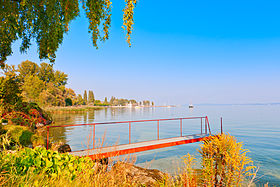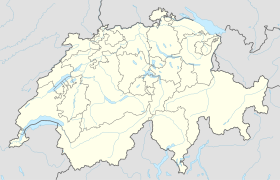Saint-Aubin-Sauges
| Saint-Aubin-Sauges | ||
|---|---|---|
| State : |
|
|
| Canton : |
|
|
| District : | No district division | |
| Municipality : | La Grande Béroche | |
| Postal code : | 2024 | |
| former BFS no. : | 6414 | |
| Coordinates : | 549 323 / 194074 | |
| Height : | 469 m above sea level M. | |
| Area : | 7.71 km² | |
| Residents: | 2399 (December 31, 2017) | |
| Population density : | 311 inhabitants per km² | |
| Website: | www.lagrandeberoche.ch | |
|
Saint-Aubin-Sauges |
||
| map | ||
|
|
||
Until December 31, 2017, Saint-Aubin-Sauges was a municipality in the Boudry district of the canton of Neuchâtel in Switzerland .
geography
Saint-Aubin-Sauges is 16 kilometers southwest of the canton's capital Neuchâtel (as the crow flies). The double community extends in the Béroche on the southern slope of the Jura , near the shores of Lake Neuchâtel . Saint-Aubin is located at 469 m above sea level. M. on a small alluvial cone, suction at 486 m above sea level. M. in a panoramic location around 50 m above lake level.
The area of the 7.7 km² former municipal area comprises a section on the north-western shore of Lake Neuchâtel north of the mouth of the La Vaux brook . The communal soil extends from the lakeshore in a narrow strip to the northwest over the valley of the village stream of Saint-Aubin up the slope, which rises relatively gently in the lower part, to the Bois du Devens . The steep slope of the Soliat anticline begins above this forest . In the extreme northwest, the area includes the ridge of the Soliat chain with the Crêt aux Moines ( 1445 m above sea level ) and the highest point of the municipality near the summit of the Soliat ( 1460 m above sea level ). The border runs along the steep drop of the Creux du Van rock arena . On the Soliat there are extensive Jura high pastures with the typical mighty spruce trees , which either stand individually or in groups. In 1997, 11% of the municipal area was in settlements, 39% in forests and woodlands, 49% in agriculture and a little less than 1% was unproductive land.
The municipality of Saint-Aubin-Sauges consisted of the two districts of Saint-Aubin and Sauges as well as numerous individual farms on the slopes of the Béroche and on the Jura heights. Neighboring communities of Saint-Aubin-Sauges were Vaumarcus , Fresens , Montalchez and Gorgier .
population
| Population development | |
|---|---|
| year | Residents |
| 1850 | 778 |
| 1900 | 1105 |
| 1950 | 1358 |
| 1960 | 1560 |
| 1970 | 2058 |
| 1980 | 2085 |
| 1990 | 2253 |
| 2000 | 2426 |
With 2399 inhabitants (as of December 31, 2017), Saint-Aubin-Sauges was one of the larger municipalities in the canton of Neuchâtel. 84.7% of the residents are French-speaking, 4.7% Portuguese-speaking and 4.3% German-speaking (as of 2000). The population of Saint-Aubin-Sauges has grown steadily over the course of the 20th century, with the greatest growth rates being recorded during the 1960s. The settlement area of Saint-Aubin has merged seamlessly with that of Gorgier.
politics
The voting shares of the parties at the 2015 National Council election were: FDP 29.4%, SP 28.1%, SVP 17.5%, GPS 7.9%, PdA 7.2%, glp 4.3%, CVP 3.2 %, BDP 1.0%.
economy
Until the middle of the 19th century, Saint-Aubin-Sauges was a town mainly characterized by agriculture . After that, industry gradually gained a foothold in the village, initially with the textile trade and watchmaking , and asphalt was also mined and processed. In the last few decades, Saint-Aubin-Sauges has developed into a residential community. Today the industry focuses on metalworking , the manufacture of precision tools and clocks, and the construction trade. Many workers are also employed in the service sector. Agriculture only plays a minor role. In the area of Sauges there are some vineyards (see also the article on viticulture in Switzerland ), in addition arable farming predominates in the lower layers , while cattle and dairy farming predominate on the Jura heights . Many employed people commute to work in Neuchâtel .
traffic
Saint-Aubin-Sauges has good transport links. It is located near the main road 5 from Neuchâtel to Yverdon . With the opening of a section of the A5 motorway in 2002, the main road near Saint-Aubin was relieved of through traffic. The A5 passes under Saint-Aubin and Sauges in a tunnel each. On November 7, 1859, the Neuchâtel – Yverdon railway line was inaugurated; the previously winding route in the area of Saint-Aubin and Sauges has been moved into a tunnel. The Gorgier-Saint-Aubin train station is on the border between the two municipalities. Bus routes from this train station to Yverdon, Boudry and Provence provide fine distribution in public transport .
history
Along the beach at Tivoli between Saint-Aubin and Sauges, the remains of coastal settlements from the Neolithic ( Cortaillod culture ) were found, including a small wooden bowl with decorations made from birch bark. Buried menhirs were discovered during the construction of the A5 motorway . Tumuli bear witness to the settlement during the Hallstatt and Latène periods . There are also traces of Roman and Burgundian times .
The first written mention of Saint-Aubin was in 1176 under the name of Sancti Albini . Sauges first appeared in the documents in 1340 as villa de Sauges . The name is derived from the Latin word salix ( willow ). Since the 11th century, Saint-Aubin has been the ecclesiastical center of the area, which was donated to the Abbot of Saint-Maurice by the Bishop of Lausanne in 1176 . It included the Béroche (from the Latin parochia , parish ). In 1531 the Reformation was introduced in the Béroche . In secular affairs, Saint-Aubin and Sauges were part of the Gorgier Burgvogtei , which came under the sovereignty of the Counts of Neuchâtel in 1344. Saint-Aubin was the seat of the court. From 1648 Neuchâtel was a principality and from 1707 it was linked to the Kingdom of Prussia through personal union. In 1806 the area was ceded to Napoleon I and came to the Swiss Confederation in the course of the Congress of Vienna in 1815 , whereby the kings of Prussia until the Neuchâtel trade in 1857 also remained princes of Neuchâtel. Since July 2, 1888, Saint-Aubin and Sauges have been a single municipality.
Attractions
The current building of the reformed village church of Saint-Aubin dates largely from 1811, parts of the nave and the choir are from 1637. The oldest remaining part is the Gothic front tower, which was probably built in the 15th or 16th century. In the center of Saint-Aubin there are some characteristic town houses from the 16th to 18th centuries.
Web links
- Official website of the municipality of Saint-Aubin-Sauges (French)
- Aerial photography
- Olivier Girardbille: Saint-Aubin-Sauges. In: Historical Lexicon of Switzerland .
Individual evidence
- ^ Election du Conseil National du October 18, 2015, Résultats des partis - Les suffrages. (aspx) (No longer available online.) Chancellerie d'État neuchâtelois, October 18, 2015, archived from the original on November 1, 2015 ; Retrieved October 30, 2016 (French). Info: The archive link was inserted automatically and has not yet been checked. Please check the original and archive link according to the instructions and then remove this notice.




